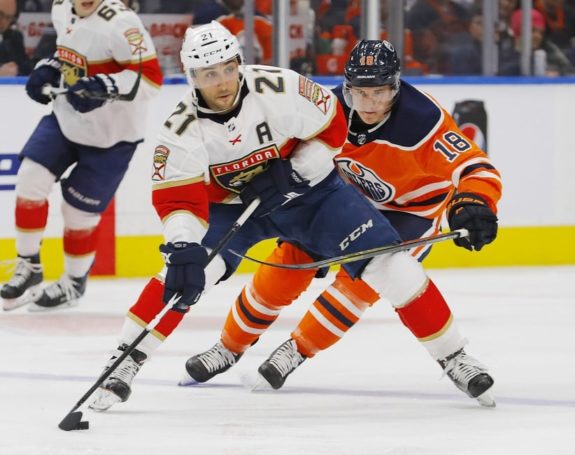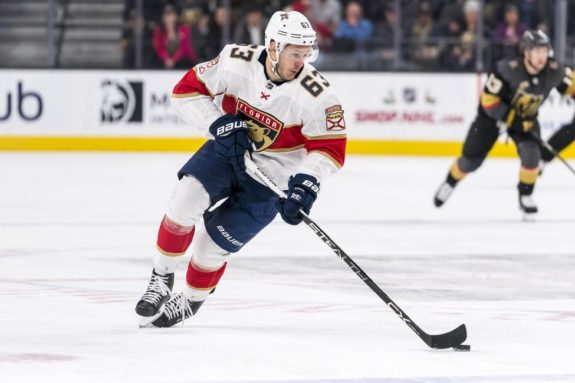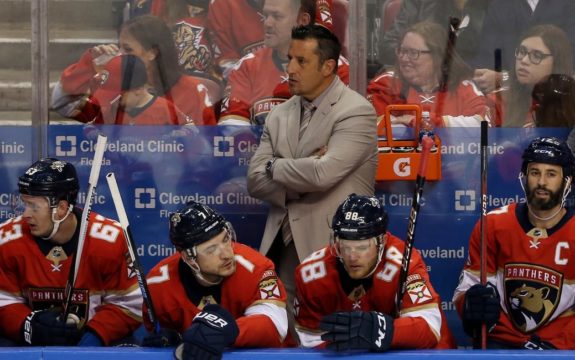When the Florida Panthers took the ice for the 2017-18 National Hockey League season, it was immediately evident something was considerably different.
The once-tentative Panthers played a much different – and much more effective – style under first-year head coach Bob Boughner, putting opposing teams on their heels with an emphasis on speed and offensive aggression.
At the end of the regular season, Florida was the number-one team in the NHL in shots per game, averaging 34.4 per contest.
Naturally, a team taking more shots should be expected to score more goals. It’s no surprise, then, that the Panthers’ strategy overhaul produced career seasons for many of their top players.
Panthers Taking More Shots
Of the 13 Panthers skaters that qualified for this analysis (see the end of this article for an explanation), nine saw their average number of shots per game increase this season, in comparison to their previous career numbers. The average difference across these 13 players was +0.24 shots per game; a modest increase, to be sure.

However, exclude from the analysis Frank Vatrano (who only had 16 games to adjust after arriving via trade) and Radim Vrbata (who had a miserable, uninspired campaign ahead of his retirement), and that figure jumps to 0.43 – almost half a shot more per night.
In fact, only Jamie McGinn and Colton Sceviour showed a decline in their shots-per-game totals, with Sceviour’s decrease a paltry 0.06 per contest.
Panthers Stars’ Shooting Shining
Florida’s top five goal-scorers from this past year make up all but one of the six skaters whose shot totals improved the most.
Aleksander Barkov (27 goals) and Vincent Trocheck (31 goals) averaged 1.17 shots per game more in their first year under Boughner than their respective career averages leading up to this season.
Not to be outdone, Evgenii Dadonov (28 goals) took 1.00 more shots per game, while Nick Bjugstad (19 goals) and Jonathan Huberdeau (27 goals) took 0.41 and 0.35 more, respectively.
Panthers Maintain Shooting Percentage
The shooting percentages of Panthers players stayed roughly constant with regards to their respective career averages, showing only a miniscule 0.04 percent decline on the whole.
Interestingly, for the five top-scoring players mentioned above, the average difference in shooting percentages between their 2017-18 campaigns and career averages was actually a modest +0.17%.

Were the Panthers simply instructed to wing more shots at the net, one would expect to see significant decreases in shooting percentage across the board, corresponding to the increases in overall shot totals.
However, it appears Boughner’s coaching enabled the Panthers, particularly their stars, to not only generate more shots, but also a proportionate increase in shots of high-quality. Very impressive.
Panthers’ Goals-For Total Misleading
As one might expect, an increase in shots plus a shooting percentage that was, on the whole, relatively stable, generated more goals for the Cats.
Florida ranked 14th in the NHL with 245 goals for. That’s not terribly impressive, though it’s important to take into account the abject lack of depth behind the Panthers’ top two lines. Consider that, after Bjugstad, who ranked fifth on the team amongst forwards in both goals and points (19 and 49, respectively), the next-closest Panther was McGinn, with 13 goals and 29 points.
Even despite a lack of talent to wholly capitalise on Boughner’s offensively beneficial style, the 245 goals the Panthers scored as a team was actually 40 more than the year previous.
Moreover, each Panthers player, on average, scored 0.05 more goals per game in 2017-18 than they’d tallied across the rest of their careers. Over 82 games, that averages out to an extra 4.1 goals per player than would otherwise have been expected.
Panthers’ Premium Players Scoring More Goals
Naturally, this boost in goals per game is weighted towards the more talented end of the spectrum, with Dadonov (+0.20), Trocheck (+0.11) and Huberdeau (+0.10) showing the three biggest increases.
Fortunately for the Panthers, this trio also played 74, 82 and 82 games, respectively, meaning they were able to translate their augmented production into consistent results for the Cats, setting career bests in the process.
Dadonov, who had only 10 goals in 55 career NHL games coming into 2017-18, obliterated his season-best of eight by putting up 28. Trocheck finished with 31 goals, six more than his previous best. And Huberdeau tallied 27, well clear of his high-water mark of 20 – and still has room to grow.
Barkov was no slouch, either, scoring 0.05 more goals per game than his career average, putting home 27 in 79 games.
Admittedly, his career-best is 28, which he scored in only 66 games during the 2015-16 season.
That said, Barkov led the team in points this year with 78 – 19 more than his previous best (also set in 2015-16), so it’s reasonable to suggest he benefitted from the offensive boost in areas other than goal-scoring. Plus, he still has some room to grow on the scoring front; Boughner has said many times he’d like Barkov to be “more greedy.”
Panthers’ Offensive Tide Lifting All Boats
It wasn’t just the stars reaping the rewards of the change in strategy Boughner initiated.
Sceviour (11) and Jared McCann (nine) both tied career highs in goals, while Denis Malgin set a new personal best with 11 of his own. For what it’s worth, even tough guy Micheal Haley got in on the act, scoring three times to top his previous best of two.
The Panthers forward corps will be bolstered next season with the (likely) arrivals of Henrik Borgstrom and Owen Tippett. Thus, players like McCann and Malgin who – despite career-best seasons – struggled at times to provide the secondary scoring the Panthers so desperately needed, should receive further boosts in production thanks to an injection of talent into the lower lines.
Panthers Aren’t Perfect…Yet
Having heaped praise on Boughner’s system and how it has been a boon to the Panthers’ rates of shot generation and conversion, it should also be noted the Cats gave up 34.6 shots per game – third-worst in the NHL, and allowed 243 goals – which ranked 18th.
That said, a certain amount of understanding for these struggles is required, given the Panthers had to adjust to a completely different playing style, one which proved difficult for many players away from the puck and in the defensive zone. Florida also had a distinct lack of depth on the back end – even moreso than in the forward corps, further exacerbating the problem.

Though the second half of the season went much better, look for the defense corps to be augmented in the offseason and, overall, for next year to go a whole lot more smoothly from a stylistic perspective.
Panthers’ Top Players Purring
Ultimately though, Boughner managed to wring career-best seasons out of players up and down his lineup, a tremendously impressive feat for any coach, let alone one who’s only been in the league a year. The fact those benefitting the most from his tutelage happen to be Florida’s best players is another encouraging sign.
In a league moving towards speed and skill – yet often left wanting for offense, Boughner has found a way to play a fast, aggressive game and increase the production of his offense, despite having comparatively little to work with. Plus, as mentioned, his already productive lineup should receive a nice boost come the fall.
Thus, with Boughner behind the bench, it certainly appears to be a promising time for the Panthers.
Please note the above analysis does not include defensemen (given the nature of the position with regards to shooting and scoring), players who played fewer than 10 games with the Panthers in 2017-18 (sample size too small), and any NHL-defined rookies (no career basis for comparison).